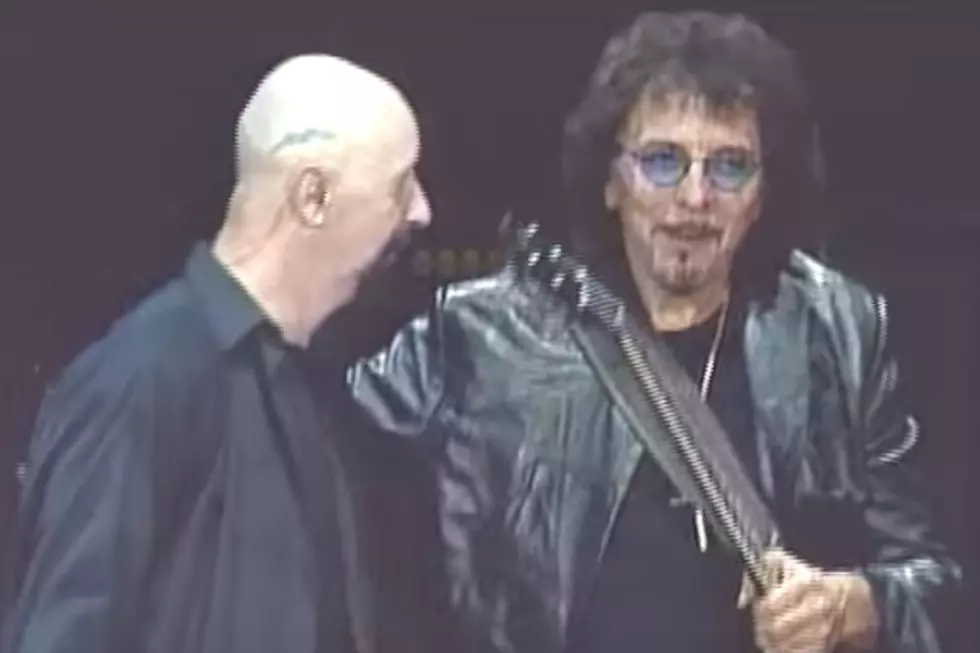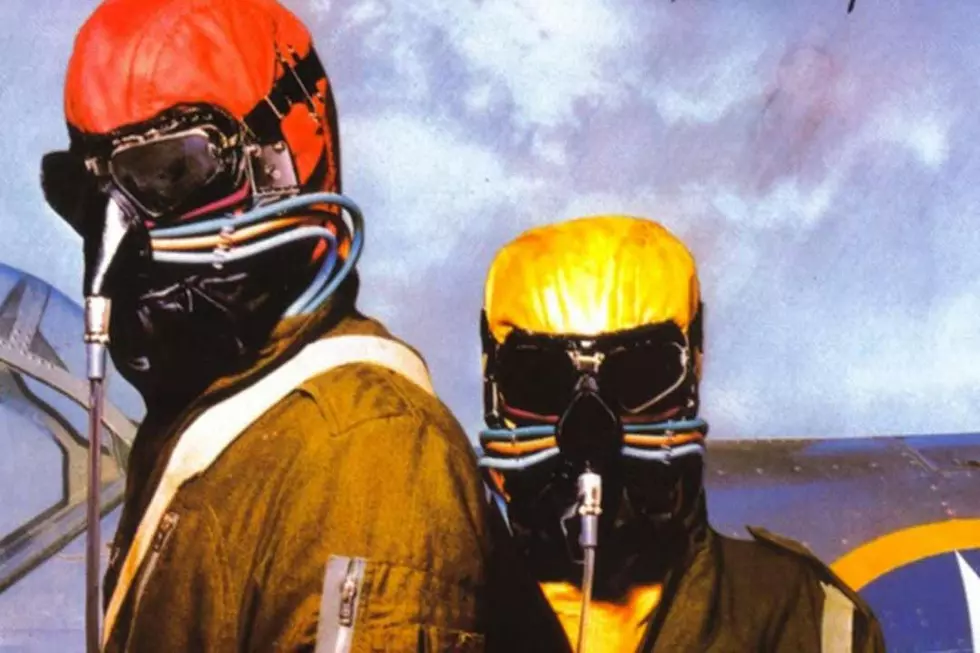
Black Sabbath’s Debut: A Track-by-Track Guide to Metal’s Birth
Fittingly released on Friday the 13th in February 1970, Black Sabbath's self-titled debut album entwines dark, disturbing lyrics with heavy propulsive music freighted with gravitas and dread in a brand new genre: heavy metal.
Even the narrative of how the group’s sound came together feels loaded with folklore: Four young musicians from the bleak, dead-end industrial town of Birmingham, England, banded together as Earth before adopting a new name derived from Italian horror director Mario Bava’s anthology film Black Sabbath. The sinister moniker coincided with an innovative sound forged from necessity. Guitarist Tony Iommi had sliced off the tips of two of his fingers in a factory accident and, after devising a set of prosthetic fingertips with a melted-down plastic detergent bottle, he relearned to play guitar on light-gauge banjo strings by tuning down.
The resulting guttural sound was fattened because bassist Geezer Butler had previously been a guitarist. Instead of playing rhythmic or melodic runs, he doubled Iommi’s thundering riffs. Likewise, drummer Bill Ward, who had gigged with Iommi in previous bands, eschewed keeping four-four time to play around the glacial riffs, filling out the sound with jazzy hi-hat and rolling tom-toms. Singer Ozzy Osbourne’s banshee wails imbued the scary lyrics, composed mostly by Butler, with conviction without catharsis. Sabbath’s tales of damnation and madness offered no release from tension.
Complementing Osbourne’s interpretation of such dark and unconventional narratives, the band eschewed traditional song structures, instead crafting each track from a chain reaction series of Iommi’s powerful melodic riffs. And all of this experimentation and innovation was quickly bashed out by Sabbath in a London studio in November 1969.
The result was housed in a sleeve that resembles a malign talisman. A spectral lady with a Mona Lisa smile stares balefully from a contemporary Hammer horror movie landscape. Except for the smile, the figure resembles Miss Jessup, the weeping ghost who possesses a young girl in the 1961 British film The Innocents, an adaptation of Henry James’ ghostly The Turn of the Screw.
All of this is true, but as with all historic tipping points, there’s more to the tale than the official take. In addition to the down-tuned proto-heavy metal that has influenced bands as diverse as Soundgarden and Metallica, Black Sabbath also features another music genre: blues-based hard rock. If '60s psychedelic music was a bucolic acid trip, late-'60s and early '70s hard rock was the comedown.
As Earth, Iommi, Osbourne, Butler and Ward cut their teeth on the blues, but their take differed from their forebears and contemporaries like Blue Cheer, Vanilla Fudge and Cream. While those heavy groups focused on virtuoso guitar solos, Iommi’s genius resided in composing killer riffs – though cuts on Black Sabbath prove he’s no stranger to the solo. More important, Sabbath’s debut reveals the blues as something scary. In Iommi’s and Osbourne’s hands, a blues lick and a crying harmonica seem unearthly rather than earthy. It’s as if in listening to blues legends Skip James or Son House, the members of Sabbath were hearing the voices of long dead ghosts.
Make no mistake, Black Sabbath is the birth of metal, but it’s also a record of the band’s distinctive take on the music that spawned the genre they created. Their debut album is a record of the dark alchemy Iommi, Osbourne, Butler and Ward performed to forge something new. It’s a snapshot of a revolution. Below, we outline the stories behind each of the songs found on the U.S. version.
“Black Sabbath”
The boys from Birmingham open with their most game-changing tune, a composition so powerful it threatens to overshadow the rest of their debut. The sound effects of howling wind, torrential rains and a tolling church bell continue for half a minute before Iommi and Butler unleash a slow, deliberate riff with a coiling coda like a scorpion’s tail. The guitarist and bassist had been listening to “Mars, the Bringer of War” from Gustav Holst’s suite The Planets, and decided to duplicate what they heard.
Sabbath’s descending riff is derived from a combination of three notes that goes by many names: The tritone, the devil’s interval and diabolus in musica (devil in music). Even though the devil’s interval was never banned by the medieval Catholic Church, as many have claimed, it sets “Black Sabbath" off to an unsettling start. Unlike most of the album, the lyrics are Osbourne’s, his interpretation of Butler’s disturbing post-sleep vision of a baleful figure watching the bassist from the foot of his bed.
Osbourne sings about Satan, but it’s not a celebration sprinkled with maniacal laughter. Instead, the singer takes the role of a poor bastard ensnared in the evil one’s web. Sabbath were subsequently lumped in with bands like Coven and Black Widow who staged black masses, complete with altars composed of naked women. But as “Black Sabbath” illustrates, Osbourne is relating a deeply moral horror story, a warning not to mess with the devil.
The signature riff shifts to a canter, replete with howling double-tracked guitars, as Osbourne wails like the trapped protagonist of an H. P. Lovecraft story. Iommi’s coruscating guitar gallops to a false ending. Then suddenly there’s one more burst of riffing guitar, like a monster reviving just when you think it’s been killed.
“The Wizard”
“The Wizard” kicks off with Osbourne’s locomotive harmonica wail before Iommi joins in with a start-stop blues-based riff. After the revolutionary opener, it seems like Sabbath are going to settle into a John Mayall and the Bluesbreakers-style hard rocker, but heavy metal emerges, ensnared in Iommi’s coiling rattlesnake riff. Osbourne slips into J.R.R. Tolkien territory as he sings about a spell-weaving wizard, and the song turns into a call and response between Osbourne’s vocals and Iommi and Butler's dive-bombing combined riffs. In one track, Black Sabbath introduce the two music styles prevalent in their debut and weave them together into a Gordian’s knot of howling vocals, growling bass, skittering drums and corkscrewing guitar.
“Wasp”
The third track on Black Sabbath is a medley, presumably derived for the band’s composition method of crafting tunes from jams driven by Iommi’s series of cascading riffs. “Wasp,” the first part of the medley, rides a slurring swaggering riff that dovetails into an elastic grind atop Butler’s low bubbling bass.
“Behind the Wall of Sleep”
With a title derived from H. P. Lovecraft’s science-fiction short story Beyond the Wall of Sleep, the second part of the album’s first medley rides Ward’s shuffling slipknot drums and an Iommi riff that sounds like a faux-Native American leitmotif from a Hollywood Western. This opening cascades into a volley between the incantation of Osbourne’s vocals and the grinding crunch of Iommi’s guitar doubled by Butler’s bass. “Wall of Sleep"’s wall of sound drops out for Ward’s jazzy syncopated drums.
“Bassically”
As its punning title implies, “Bassically” is Butler’s chance to step into the spotlight with an extended solo. Betraying his background as a guitarist, he employs a wah-wah pedal and plays melody lines usually associated with lead guitar. Butler’s prowling bass dips into a black hole of silence before reemerging on the next cut.
“N.I.B”
“N.I.B.” takes its name from Osbourne’s description of Ward’s pointed beard, which the singer felt resembled a pen nib. The song rides Butler’s distorted shape-shifting fuzz bass into a thicket of Iommi’s honking blues-inspired guitar. Iommi switches back to metal mode for a swaggering riff that is doubled by Ward and then tripled by Osbourne. The three-part guitar, bass and vocals theme folds into a time signature-shifting bridge that slides back into the initial honking call-and-response blues-rock riff.
Osbourne then sings in character as the fallen angel Lucifer, a development that probably furthered the band’s identification with Satanism in detractors’ minds. Iommi then takes the tune out with a tangled scrawl of slurred and warped double-tracked guitar that concludes with a cacophonous howl.
“Wicked World”
Ward’s skipping hi-hat sets up a serpentine Iommi riff. Butler joins in, playing an identical riff an octave lower than Iommi’s. Here, Sabbath slip into a template established earlier on the album, a call-and-response between a shared blues-rock riff on bass and guitar and Osbourne’s vocals, which are drawled in an approximation of Mick Jagger or the Seeds’ Sky Saxon. Iommi shifts to a jangling cascading guitar fill. It’s possible he’s paying tribute to an important influence, Gypsy jazz guitarist Django Reinhardt. (The Sabbath guitar player has recounted how the example of Reinhardt, who lost the use of his fingers in a caravan fire, encouraged Iommi to persevere in relearning how to play.)
Iommi’s rapid-fire cyclone solo takes the spotlight, setting the benchmark for future metal shredders. The tune returns to the dual bass-and-guitar riff before it all collapses in a satisfying knot of coruscating feedback.
“A Bit of Finger”
The title “A Bit of Finger” may or may not be a reference to Iommi’s accident. If so, it’s the only clue in the first installment on Sabbath’s second medley of the album, which is dominated by Iommi’s plangent cascading acoustic-style finger picking on a razor-toned guitar. Boinging Jew's harp and Osborne’s gravely pensive vocal join in on this short interlude.
“Sleeping Village”
A stentorian call-and-response blues-rock riff ushers in “Sleeping Village.” Thundering bass and guitar nudge the track into heavy-metal territory, though at times the tune is reminiscent of Vanilla Fudge. The initial riff gives way to Iommi’s squawking guitar, which spirals over Butler’s shuddering bass. Osbourne’s vocals drop out relatively early, setting up a welter of whiplash jamming, where the band alternates loud and quiet sections. The song returns to the initial thundering brontosaurus riff before coiling to a close.
“Warning”
The final piece of the medley, closing the original vinyl album’s second side, is Black Sabbath’s sole cover on their debut, a version of “Warning” by the Aynsley Dunbar Retaliation. Though Osbourne sings in an uncharacteristic drawl, this may be his most melodic performance on the album. Butler’s fuzz bass further thickens the already heavy sound, while Iommi peels off a series of excoriating blues-rock solos with a guitar sound far more grimy and slippery than Eric Clapton’s.
The guitarist runs though several styles and tones here, including heavy reverberating bent-note blues, blazing loop-de-loops and spooky hovering feedback that suggests a UFO ascending.
Running more than 10 minutes, most which is devoted to Iommi’s seesawing soloing, “Warning” strays far from the title track’s innovation, opting for a recap of the kind of extended blues-rock jamming that Black Sabbath would soon leave behind. Though “Warning” is disappointingly traditional after highlights like “The Wizard,” the song brings Black Sabbath’s inaugural effort to a credible conclusion.
Black Sabbath Lineup Changes: A Complete Guide
More From Ultimate Classic Rock









